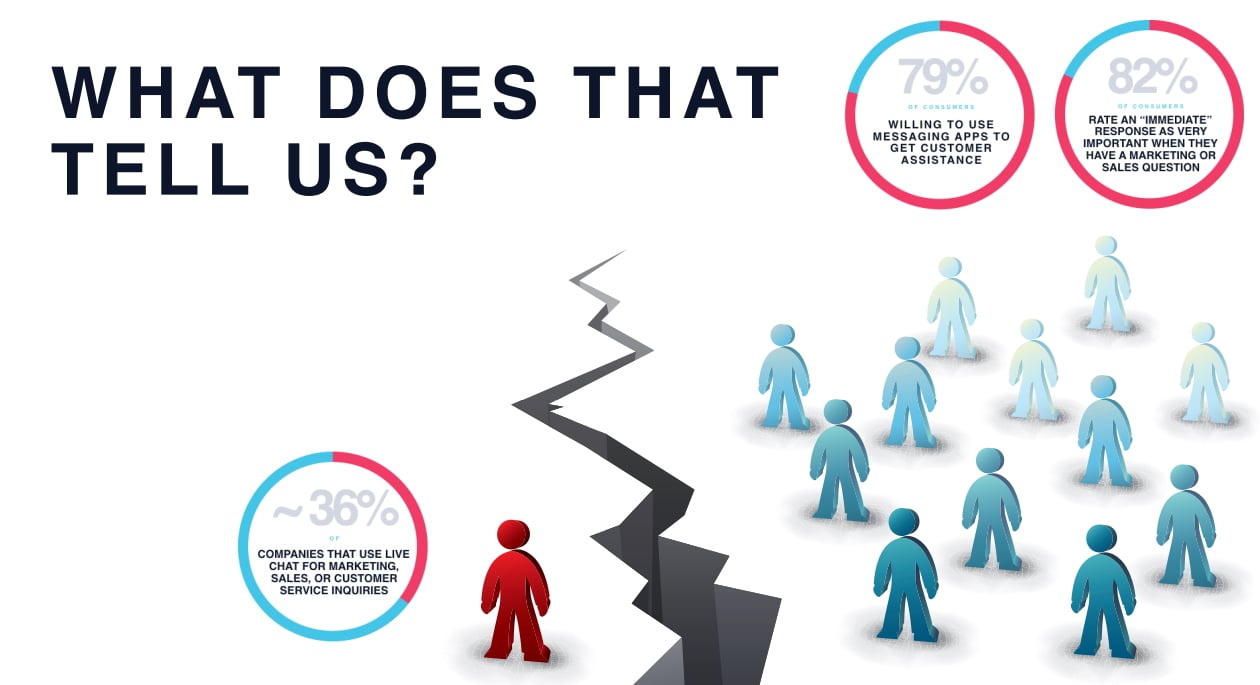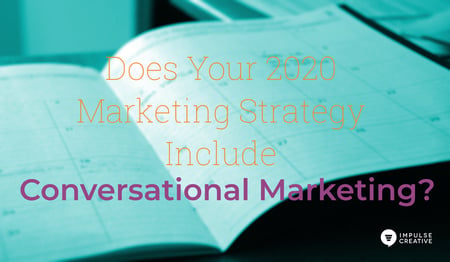So many shiny objects. So little time.
As soon as you focus on a successful marketing tool, along comes a squirrel to distract you.

You’ve figured out blogging for business. You’re measuring your marketing efforts with a great dashboard. You’re rocking it on social media.
Heck, you’re even creating videos for YouTube and LinkedIn. 🚀🏆
And here comes conversational marketing as one more tool to fit into your business growth toolbox.

We get it. It’s annoying. Here’s the thing though. If you’re not considering conversational marketing as part of your 2020 marketing strategy, you’re going to miss out on a critical component of a successful modern marketing playbook.
Conversational Marketing Stats:
- 79% of consumers are willing to use messaging apps to get customer service
- 82% of consumers rate an “immediate” response as very important when they have a question
- 36% of companies use live chat for marketing, sales or customer service inquiries

As you can see, almost every customer you interact with wants to communicate through chat. They want a conversation. And yet so many businesses, not just yours, ignore live chat.
It’s time to really serve our customers.
One quick note: You’ll want to know the two sides to conversational marketing tool, live chat with a human and chatbots.
Human vs. Chatbots
One of the biggest opportunities in conversational marketing is using chatbots to engage visitors and start a conversation. Similar to how marketing teams are using intent and time-based automation, companies can use chatbots to create micro conversations that are contextually relevant, timely and drive a natural conversation.
Let’s face it, nothing’s better than one-on-one human interaction to provide value, but in most cases, it’s not scalable. We live in an instant gratification world. While a five minute response to a lead via email is great, it seems like ages when it was thought of from a chat point of view. AI and chatbots can leverage this opportunity and bridge this scalability gap to: open the conversation, answer common questions, qualify leads and even set meetings, in a natural way that your prospect will love.
Ready to dive into conversational marketing for your 2020 marketing strategy and explore chat marketing tactics?
Add Conversational Marketing to Your 2020 Marketing Strategy
Step 1: Map Out Buyer's Journey
Before you can start with a meaningful conversation or content piece, you have to know where it is intended to show up in the buyer's journey. Ask yourself questions about how the content is going to be consumed and consider how the user story (below) ties in. Where is that user in the buyer's journey when you want them to interact with your messaging and where does the result of the conversation take them.
Step 2: Create User Stories
 While typically used in agile development, user stories are short, simple descriptions of a feature as told from the perspective of the person who desires the new capability. Usually, it’s a user or customer of the system.
While typically used in agile development, user stories are short, simple descriptions of a feature as told from the perspective of the person who desires the new capability. Usually, it’s a user or customer of the system.
These can follow a simple template:
As a [type of user], I want [some goal] so that [some reason].
By creating a conversational marketing user story, you can shift the focus from writing about benefits, to discussing them with your prospect.
Step 3: Role Play the Conversation
We love sticky notes! Use them to outline the questions and potential answers on a board or on the wall. The goal here is to map out the conversation and make it easy to adjust language and order of questions etc. Make sure your user story is top and center to keep the conversation on point.
Step 4: Identify Triggers for Next Question
Once you have your questions and potential answers outlined with sticky notes, the next step is to focus on the triggers for each question. Think about whether you’ll provide free text answers or if you’re providing buttons for the user to check (keeps the conversation natural and focused).
Step 5: Identify Different Branches of the Conversation
Now that you have your questions and potential answers outlined, decide whether you want to allow conversations to branch off to other conversation flows. This could make the conversation more contextually relevant after a simple yes/no question, or could be more advanced with multiple options to choose from.
Step 6: Publish and Promote
Get your message out there. It’s always easy to make excuses and not publish your conversations. So set it and let it out into the wild. Try implementing your conversational marketing piece on multiple mediums. Publish on Facebook Messenger and also consider using the same conversation on your website, too.
Step 7: Analyze & Iterate
Once your message is out and people are engaging with your bot, start to look for similarities where people fall off. That trend indicates areas you should consider spending time on. Add your enhancements and then continually iterate, analyze and improve the conversations.
What it Means to be Conversational

Connection
In order to have an effective conversation, you need to create a connection. That means context and understanding. If we understand where someone is coming from, it's very easy for us to start to engage in a conversation. In person that might mean eye contact and non-verbal cues.
Online, that looks different. But we can still connect through context and empathy.
Value
When developing a conversation that moves forward, thinking about value and what each side offers may seem transactional at first. However, the fact is we’re all looking for what we can give and get out of a conversation. If we want to create a meaningful conversation, we've got to make sure that it's equal on both sides.
Trust
Another aspect of an effective conversation is trust. Trust is something that has to be given on both sides in order for a conversation to be truly effective. We build trust through empathy, connection and offering value.
1-1 > 1-Many
These things add up to real connections and conversations because one-to-one is greater than one to many. Which is how we’ve always marketed to our customers.
Broadcasting our message to as many people as possible doesn’t work as well as it used to. Now we have to be ready to have conversations with one person in order to drive revenue.
The good news? We can still scale those conversations.
Always be Helpful
Conversational marketing is an easy offshoot of the inbound methodology. At its core, conversational marketing, chatbots and live chat allow for your sales and marketing teams to always be providing value to your prospective customers when they need it the most.
As you are building out your playbooks, chatbot user flows, or engaging in live chat, find ways to make it easy to help your prospects. Identify the pages where people have the most questions and if they are not sales conversations, think about updating the content on those pages to disclose the common questions right away.
Stay connected with your prospects by making it easier than ever to get the information they need. This can be a huge opportunity to win your prospect over your competition.
The Time is NOW to Get Started
In review, 2020 shouldn’t come and go without a tactical change to your overall strategy. In a world where more content is being produced, interruptions are more frequent and we’re more easily distracted than ever, we, as marketers and business owners need to focus on optimizing our conversions as much as we focus on “NEW” content. That’s why implementing conversational marketing strategies is critical.
It's also why considering a conversational marketing agency could benefit you.
At Impulse Creative, our team spends just as much time on optimizing conversion rates as we do writing the content. We are data-driven junkies. We are always looking for a way to find the most profitable ROI for our clients. And from where we stand, conversational marketing and sales is the next natural step. After all, your customers are already communicating that way. Shouldn’t you?
Calendar photo by Eric Rothermel on Unsplash





